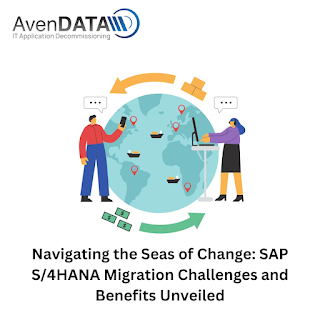Navigating the Seas of Change: SAP S/4HANA Migration Challenges and Benefits Unveiled
Introduction:
In the ever-evolving landscape of enterprise resource planning (ERP), SAP systems stands out as a beacon of innovation and efficiency. However, the journey to migrate from legacy systems to SAP systems is not without its challenges. In this blog post, we'll embark on a voyage to explore the challenges associated with SAP systems migration and uncover strategies to maximize the benefits of this transformative process.
The Challenge Horizon:
1. Data Complexity and Cleansing:
The transition to SAP systems often reveals the complexity of legacy data. Navigating through this complexity requires meticulous data cleansing to ensure that only relevant and accurate information is migrated. We delve into the strategies for untangling the data web and ensuring a seamless transition.
2. Custom Code Management:
Organizations heavily invested in custom code face the challenge of ensuring compatibility with SAP systems. Discover how a strategic approach to custom code management can mitigate risks, reduce disruptions, and pave the way for a smooth migration.
3. Stakeholder Engagement and Communication:
The success of any migration project hinges on effective communication and stakeholder engagement. We discuss the importance of transparent communication, managing expectations, and fostering collaboration to secure buy-in from all levels of the organization.
Navigational Aids:
1. Robust Planning and Assessment:
Successful navigation begins with a well-charted course. We explore the significance of robust planning and assessment, including the evaluation of existing processes and infrastructure, to identify potential bottlenecks and streamline the migration path.
2. The Power of Test Environments:
Smooth sailing requires rigorous testing. Discover how creating comprehensive test environments can help organizations identify and rectify issues before they impact the live system, ensuring a more secure and reliable migration.
3. Training and Change Management:
Empowering the crew (your employees) with the knowledge and skills required for SAP systems is critical. We discuss the importance of training programs and effective change management to ease the transition and minimize disruptions to daily operations.
Maximizing the Benefits Harbor:
1. Optimizing Business Processes:
SAP systems isn't just an upgrade; it's an opportunity to optimize business processes. Learn how organizations can leverage the advanced features of S/4HANA to streamline operations, improve efficiency, and gain a competitive edge.
2. Realizing Cost Efficiencies:
Beyond the initial investment, SAP systems migration offers long-term cost efficiencies. Explore how organizations can leverage the in-memory computing capabilities of S/4HANA to reduce data storage costs and enhance overall system performance.
3. Future-Proofing the Enterprise:
SAP systems isn't just a destination; it's a foundation for the future. We discuss how embracing this next-generation ERP system positions organizations to adapt to future technological advancements, ensuring long-term sustainability.
Conclusion:
Embarking on the SAP system migration journey is an ambitious undertaking, but with careful navigation, organizations can overcome challenges and unlock the full spectrum of benefits this advanced ERP solution has to offer. As the ERP seas continue to evolve, navigating the challenges and maximizing benefits will be crucial for organizations seeking not only efficiency today but also resilience for tomorrow's business landscapes. Smooth sailing awaits those who approach this migration with foresight, strategic planning, and a commitment to continuous improvement.

.png)
.png)
Comments
Post a Comment